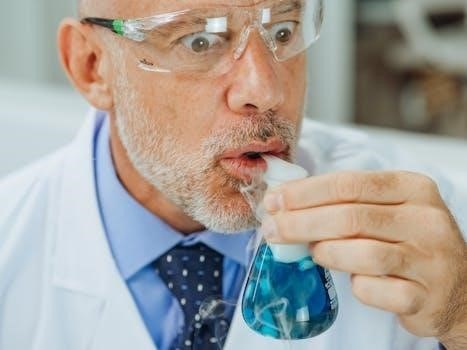Chemical Reactivity⁚ An Overview
Chemical reactivity, a core concept in chemistry, describes a substance’s propensity to undergo chemical reactions. It encompasses the interaction with other substances, leading to new compounds. This reactivity is governed by electronic configuration and influenced by thermodynamic, kinetic factors, determining reaction speed.
Definition of Chemical Reactivity
Chemical reactivity, at its core, is a measure of how readily a substance participates in chemical reactions. This involvement can manifest through interactions with other atoms, molecules, or even the substance itself, often accompanied by energy release. It’s not merely about the potential for a reaction, but also the rate at which it occurs, reflecting a kinetic property of the substance.
A more reactive species exhibits a larger rate constant for a specified elementary reaction compared to a less reactive one. This reactivity is intrinsically linked to the electronic structure of atoms and molecules, particularly the arrangement of valence electrons. The drive towards achieving stable electron configurations, often resembling filled valence shells, significantly influences a substance’s reactivity.
Factors like inductive effects, resonance, and the presence of functional groups also play crucial roles. Understanding chemical reactivity necessitates considering both thermodynamic and kinetic aspects. The ability of a substance to undergo a chemical change, leading to the formation of new compounds, defines its chemical reactivity.

Factors Influencing Reactivity
Several factors govern a substance’s chemical reactivity. Electronic configuration, particularly valence electrons, plays a crucial role. Thermodynamic stability and kinetic accessibility also influence reactivity. Inductive effects, resonance, and functional groups further modulate a substance’s reaction tendencies and determine the overall chemical behaviour.
Electronic Configuration and Reactivity
The electronic configuration of an atom or molecule is paramount in determining its chemical reactivity. Valence electrons, the outermost electrons, dictate how atoms interact to form chemical bonds. Atoms seek stability, often achieved by attaining a full valence shell, driving chemical reactions. Elements with similar valence electron configurations exhibit analogous reactivities, explaining group trends in the periodic table.
Ionization energy, the energy required to remove an electron, influences reactivity; lower ionization energies indicate greater reactivity. Electronegativity, the ability to attract electrons, also plays a significant role. Atoms with large differences in electronegativity form polar bonds, influencing reaction pathways.
The presence of orbitals (s, p, d, f) in the outer electron shell affects reactivity. Atoms with partially filled orbitals are often highly reactive, striving to complete their electron configurations through bonding. Understanding electronic configurations is crucial for predicting and explaining chemical behaviour. It provides insights into reaction mechanisms and the formation of stable chemical compounds.
Thermodynamic and Kinetic Factors
Chemical reactivity is governed by both thermodynamic and kinetic factors, influencing whether a reaction occurs and at what rate. Thermodynamics determines the spontaneity of a reaction, assessing energy changes between reactants and products. A spontaneous reaction leads to lower energy, producing more stable products. Enthalpy, the heat absorbed or released, and entropy, the degree of disorder, are key thermodynamic parameters.
Kinetics, conversely, focuses on the reaction rate, describing how quickly reactants transform into products. Activation energy, the energy barrier for reaction initiation, dictates reaction speed; lower activation energies result in faster reactions. Reaction mechanisms detail the step-by-step process of a chemical change, influencing reaction kinetics.
Thermodynamic stability doesn’t guarantee reactivity; a thermodynamically favorable reaction may proceed slowly due to a high activation energy. Catalysts accelerate reactions by lowering activation energies without altering overall thermodynamics. Understanding both thermodynamic and kinetic factors is crucial for predicting and controlling chemical reactions. It enables optimizing reaction conditions and designing efficient chemical processes.

Types of Chemical Reactions
Chemical reactions are classified based on reactants, products, or mechanisms. Common types include acid-base reactions involving proton transfer, and redox reactions involving electron transfer. Gas-forming reactions produce gases like carbon dioxide, while precipitation reactions form solid precipitates from solutions.
Acid-Base Reactions
Acid-base reactions are fundamental in chemistry, involving the transfer of protons (H+) between chemical species. These reactions are characterized by the interaction of an acid, which donates a proton, and a base, which accepts a proton. The concept extends beyond traditional Arrhenius definitions to include Brønsted-Lowry and Lewis acid-base theories, encompassing a broader range of chemical interactions. In aqueous solutions, acid-base reactions often result in the formation of water and a salt.
The strength of acids and bases is quantified by their dissociation constants (Ka and Kb, respectively), which reflect their ability to donate or accept protons. Strong acids and bases completely dissociate in water, while weak acids and bases only partially dissociate, establishing an equilibrium between the undissociated and dissociated forms.
Acid-base reactions play crucial roles in various chemical and biological processes, including catalysis, pH regulation, and enzymatic reactions. The pH scale, a measure of hydrogen ion concentration, is essential for understanding and controlling acid-base chemistry in different systems.
Redox Reactions
Redox reactions, short for reduction-oxidation reactions, are chemical processes involving the transfer of electrons between reactants. Oxidation is defined as the loss of electrons, while reduction is defined as the gain of electrons. These reactions always occur in tandem; one substance loses electrons (is oxidized) while another gains electrons (is reduced). Redox reactions are fundamental to many chemical and biological processes, including combustion, corrosion, and cellular respiration.
Oxidation states, also known as oxidation numbers, are used to track the movement of electrons in redox reactions. An increase in oxidation state indicates oxidation, while a decrease indicates reduction. Balancing redox reactions often requires careful consideration of electron transfer and the use of half-reactions to separate the oxidation and reduction processes.
Redox reactions are essential in industrial chemistry for the production of various materials, including metals and plastics. They also play a critical role in energy storage technologies such as batteries and fuel cells. Understanding redox reactions is vital for comprehending a wide range of chemical phenomena.

Reactivity Series
The reactivity series arranges metals by their reactivity, indicating their tendency to undergo chemical reactions. Metals higher in the series readily displace those lower down from compounds. This series aids in predicting the outcomes of displacement reactions in chemistry.
Metals Reactivity Series
The metals reactivity series is a fundamental concept in chemistry, ranking metals based on their relative reactivity. This arrangement, typically presented as a descending order, reflects a metal’s ability to undergo chemical reactions, such as displacement reactions or corrosion. More reactive metals readily lose electrons and form positive ions, displacing less reactive metals from their compounds.
The series is constructed through experimental observations, comparing the reactions of different metals with various substances, including water, acids, and oxygen. Metals higher in the series, like potassium and sodium, exhibit vigorous reactions, while those lower down, such as gold and platinum, are relatively inert.
Understanding the metals reactivity series is crucial for predicting the outcomes of chemical reactions and designing experiments. It finds applications in diverse fields, including metallurgy, electrochemistry, and corrosion prevention. By referencing the series, chemists can determine whether a specific metal will displace another from a solution or predict the likelihood of corrosion in a given environment.

Reactivity and Reaction Mechanisms
Chemical reactivity is intricately linked to reaction mechanisms, providing a detailed understanding of how chemical transformations occur. Reaction mechanisms describe the step-by-step sequence of elementary reactions that convert reactants into products, revealing the movement of electrons and the formation or breaking of chemical bonds.
Understanding reaction mechanisms allows chemists to predict the rate of a reaction, identify potential intermediates, and optimize reaction conditions. These mechanisms often involve reactive intermediates, such as carbocations or free radicals, which are short-lived species that play a crucial role in the overall transformation.
Factors influencing reactivity, such as electronic configuration, steric effects, and solvent effects, are also critical in determining the reaction mechanism. For example, inductive effects and resonance can significantly alter the electron density within a molecule, influencing its reactivity towards electrophiles or nucleophiles.
The study of reaction mechanisms is essential for designing new chemical reactions, developing efficient synthetic strategies, and understanding complex biological processes. By elucidating the pathways through which reactions proceed, chemists can gain deeper insights into the fundamental principles governing chemical reactivity.
